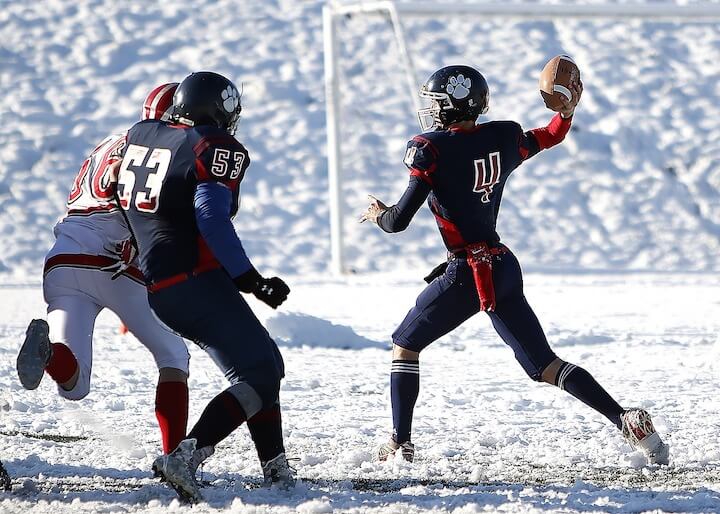Every play on offense is one of two things -- either a run or a pass.
Runs happen when the quarterback takes the snap and hands the ball off to another player, who will try to run it upfield as far as possible. While passes occur when the QB throws the ball forward from his position on the field.
The forward pass was a revolutionary change that occurred in football more than 100 years ago -- in 1906. Since then, a lot has changed in this area of the game.
There are rules that govern how a forward pass must occur, and any deviation from that is considered an illegal forward pass.
Let's take a closer look at this issue and how it's applied in games today.
What is an Illegal Forward Pass in Football?
The first forward pass occurred in 1906, and since then officials added the "illegal forward pass" rule -- tweaking it as needed in the years that followed.
Originally, offenses could only attempt a forward pass from at least five yards behind the line of scrimmage.
Then in 1933, the NFL changed the rule to make the forward pass legal from anywhere behind the line of scrimmage.
This is the version of the rule that most people are familiar with today.
While QBs throw a large majority of these passes, other players may attempt forward passes as well.
For example, the quarterback could take a snap, toss it back to the running back who will then attempt a forward pass to a receiver downfield.
There are some limitations to this rule, though, and they fall into the category of illegal forward passes.
These are either attempted beyond the line of scrimmage or after an initial forward pass has already been completed.

Example #1: Pass Attempted Beyond the LOS
The most common way teams get called for an illegal forward pass is when a pass is attempted after already crossing the line of scrimmage.
This may happen if the quarterback is being pressured by defenders and is flushed out of the pocket.
For example:
The quarterback may roll to his left or right and start approaching the line of scrimmage while looking for a receiver to throw to. If the quarterback finds an open receiver too late in this sequence, he may end up attempting an illegal forward pass if he has already crossed the line of scrimmage.
This can easily happen, as it's hard for the quarterback to know exactly where he is on the field when he's scrambling -- though it's certainly his job to do exactly that.
This is the case where illegal forward pass penalties are probably called the most.
Example #2: A Second Attempted Forward Pass
Teams will also be called for an "illegal forward pass" if they attempt a second forward pass after completing a first forward pass.
This rule prevents the QB from throwing a quick five-yard forward pass to a receiver who then turns around and throws a deeper pass to a second receiver.
This would be illegal.
There is an exception to keep in mind, however...
If the quarterback throws the ball to a receiver who has retreated to a position slightly BEHIND where the QB begins, the receiver CAN catch the ball and throw it downfield to another receiver.
This is known as a "double pass," and it's legal because the initial throw is a lateral pass since it traveled backward -- not a forward pass.
This is an important distinction to make...
A pass attempt is considered a forward pass if it travels forward from where the passer throws it -- no matter where on the field the receiver catches it.

Penalty for an Illegal Forward Pass
In all instances of an illegal forward pass, the penalty results in the offense losing five yards.
In some cases, the penalty will also result in a loss of down.
What determines a loss of down is the specific situation, as well as the level of football -- NFL, college, high school or youth.
Conclusion
The forward pass is one of the most common offensive plays in football, yet there are football rules that lay out what's legal and what's not.
An illegal forward pass is any attempt that's made beyond the line of scrimmage, or any attempt that's made after a first forward pass.
When this happens, the referee will call a penalty, and the offense will lose five yards -- and possibly a down as well.

